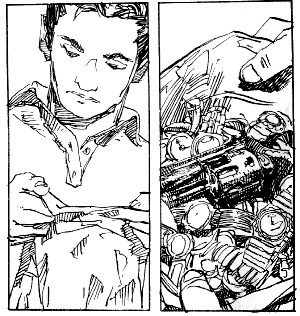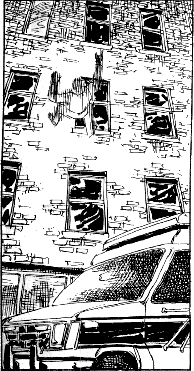A History of Violence

 When I first heard about this book, I thought it was like Paradox Press’ “Big Book” series. They’d had The Big Book of Death, The Big Book of Urban Legends, The Big Book of Thugs, and so on. So when I heard the title “A History Of Violence“, I assumed it was just that: a history, of violence. I oughta pay better attention, I guess.
When I first heard about this book, I thought it was like Paradox Press’ “Big Book” series. They’d had The Big Book of Death, The Big Book of Urban Legends, The Big Book of Thugs, and so on. So when I heard the title “A History Of Violence“, I assumed it was just that: a history, of violence. I oughta pay better attention, I guess.
 In fact, it’s part of Paradox’s “Graphic Mystery” line, a novel about an unremarkable man… a man with a secret… a man who - unknown to his friends and family - may have a history of violence. It’s not a “whodunnit” mystery. The mystery lies in the question of what exactly Tom McKenna has been hiding from his wife, his kids, the neighbors, and seemingly everyone else who knows him.
In fact, it’s part of Paradox’s “Graphic Mystery” line, a novel about an unremarkable man… a man with a secret… a man who - unknown to his friends and family - may have a history of violence. It’s not a “whodunnit” mystery. The mystery lies in the question of what exactly Tom McKenna has been hiding from his wife, his kids, the neighbors, and seemingly everyone else who knows him.
I’ve never spent much time in the “mystery” section of bookstores, because the whodunnit genre doesn’t really interest me. But I heard some good things about this particular book, and I figured that it’d be handy for reading on one of my trips to see Andy. If there’s more like this in the “mystery” section, I may have to do a little browsing over there.
 In case you don’t know the name, John Wagner is the guy behind Judge Dredd. (Not be confused with Martin “Hepcats” Wagner, Matt “Grendel” Wagner, or Richard “Götterdämmerung” Wagner.) But not to worry… while things get a bit gory and somewhat… well, violent at times, this story is not set in MegaCity One. It’s set in modern small-town middle America, and Brooklyn NYC a few decades earlier. Wagner crafts a tale that builds just enough tension and suspense to keep you on the edge of your seat, turning pages. While some of it strains credibility a bit (especially the Big Surprise during the last scene), the gradual development of and unveiling of Tom McKenna (or whoever he really is) makes sense.
In case you don’t know the name, John Wagner is the guy behind Judge Dredd. (Not be confused with Martin “Hepcats” Wagner, Matt “Grendel” Wagner, or Richard “Götterdämmerung” Wagner.) But not to worry… while things get a bit gory and somewhat… well, violent at times, this story is not set in MegaCity One. It’s set in modern small-town middle America, and Brooklyn NYC a few decades earlier. Wagner crafts a tale that builds just enough tension and suspense to keep you on the edge of your seat, turning pages. While some of it strains credibility a bit (especially the Big Surprise during the last scene), the gradual development of and unveiling of Tom McKenna (or whoever he really is) makes sense.
 The only other place I’ve seen Vince Locke’s art was the American Freak: A Tale of the UnMen limited series from Vertigo. I think it works even better here, in black and white. A noir crime novel like this really ought to be done that way. Locke’s sketchy style is perfect for this story, keeping things edgy and uncertain without being sloppy. The heavy cross-hatching in some of the dark outdoor scenes makes it hard to make things out… but isn’t that what happens in real life?
The only other place I’ve seen Vince Locke’s art was the American Freak: A Tale of the UnMen limited series from Vertigo. I think it works even better here, in black and white. A noir crime novel like this really ought to be done that way. Locke’s sketchy style is perfect for this story, keeping things edgy and uncertain without being sloppy. The heavy cross-hatching in some of the dark outdoor scenes makes it hard to make things out… but isn’t that what happens in real life?
The format of this book is a new one for Paradox. The height and width are a little bigger than a standard paperback novel, which is how Paradox’s initial “fiction” and “graphic mystery” offerings were published. But those were released in the same format DC uses for their superhero books: serial monthly installments. The problem is that most people don’t read books that way. They pick them up, read a chapter or a few (as they have time), and finish them over the course of a few days or a few weeks. A short novel in four volumes also makes for an awkward package to loan to a friend, take on a trip, or to buy a few months or a year after the book comes out (like now). By releasing this as a single volume (and at an affordable $9.95 for nearly 300 pages), I think they’ve finally figured out the right way to do it. (Paradox has also re-released Green Candles - originally released serially - in a similar single volume.)
If you’re looking for some beach reading this summer, this might be a good choice. It’s reasonably cheap, fits easily in a beach bag, and (because graphic novels tend to read more quickly than text novels) is less likely to keep you out so long that you get sunburned.
